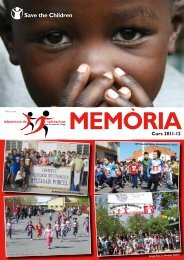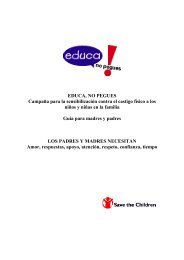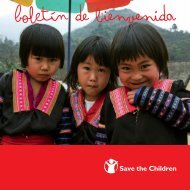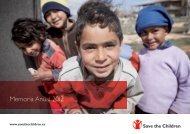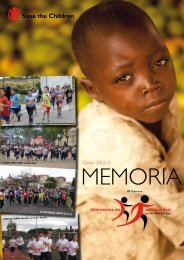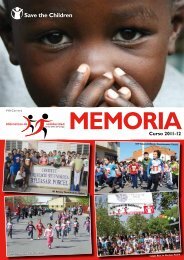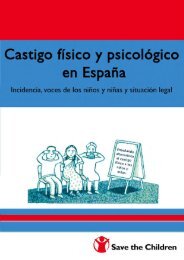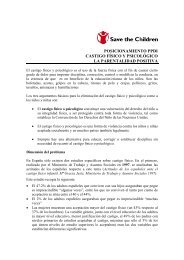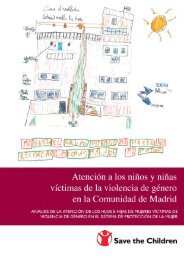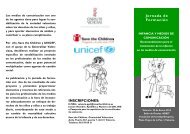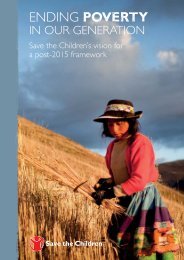Nutrition in the First 1,000 Days - Save the Children
Nutrition in the First 1,000 Days - Save the Children
Nutrition in the First 1,000 Days - Save the Children
You also want an ePaper? Increase the reach of your titles
YUMPU automatically turns print PDFs into web optimized ePapers that Google loves.
42 BreaStFeeDiNg iN <strong>the</strong> iNDUStrialiZeD WorlD<br />
BReastFeed<strong>in</strong>g PoLiCy sCoReCaRd<br />
<strong>Save</strong> <strong>the</strong> <strong>Children</strong> exam<strong>in</strong>ed maternity leave laws, <strong>the</strong> right to nurs<strong>in</strong>g breaks<br />
at work and several o<strong>the</strong>r <strong>in</strong>dicators to create a rank<strong>in</strong>g of 36 <strong>in</strong>dustrialized<br />
countries measur<strong>in</strong>g which ones have <strong>the</strong> most – and <strong>the</strong> least – supportive<br />
policies for women who want to breastfeed.<br />
Norway tops <strong>the</strong> Breastfeed<strong>in</strong>g Policy Scorecard rank<strong>in</strong>g. Norwegian mo<strong>the</strong>rs<br />
enjoy one of <strong>the</strong> most generous parental leave policies <strong>in</strong> <strong>the</strong> developed world.<br />
After giv<strong>in</strong>g birth, mo<strong>the</strong>rs can take up to 36 weeks off work with 100 percent<br />
of <strong>the</strong>ir pay, or <strong>the</strong>y may opt for 46 weeks with 80 percent pay (or less if <strong>the</strong><br />
leave period is shared with <strong>the</strong> fa<strong>the</strong>r). In addition, Norwegian law provides<br />
for up to 12 months of additional child care leave, which can be taken by both<br />
fa<strong>the</strong>rs and mo<strong>the</strong>rs. When <strong>the</strong>y return to work, mo<strong>the</strong>rs have <strong>the</strong> right to<br />
nurs<strong>in</strong>g breaks as <strong>the</strong>y need <strong>the</strong>m. Nearly 80 percent of hospitals have been<br />
certified as “baby-friendly” and many provisions of <strong>the</strong> International Code of<br />
Market<strong>in</strong>g of Breast-milk Substitutes have been enacted <strong>in</strong>to law. Breastfeed<strong>in</strong>g<br />
practices <strong>in</strong> Norway reflect this supportive environment: 99 percent of babies<br />
<strong>the</strong>re are breastfed <strong>in</strong>itially and 70 percent are breastfed exclusively at 3 months.<br />
The United States ranks last on <strong>the</strong> Breastfeed<strong>in</strong>g Policy Scorecard. It is <strong>the</strong><br />
only economically advanced country – and one of just a handful of countries<br />
worldwide – where employers are not required to provide any paid maternity<br />
leave after a woman gives birth. There is also no paid parental leave required<br />
by U.S. law. Mo<strong>the</strong>rs may take breaks<br />
from work to nurse, but employers<br />
are not required to pay <strong>the</strong>m for this<br />
time. Only 2 percent of hospitals <strong>in</strong><br />
<strong>the</strong> United States have been certified<br />
as “baby-friendly” and none of <strong>the</strong><br />
provisions of <strong>the</strong> International Code<br />
of Market<strong>in</strong>g of Breast-milk Substitutes<br />
has been enacted <strong>in</strong>to law. While 75<br />
percent of American babies are <strong>in</strong>itially<br />
breastfed, only 35 percent are be<strong>in</strong>g<br />
breastfed exclusively at 3 months.<br />
Norway




